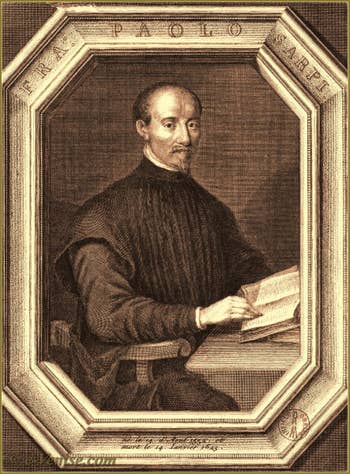History Important dates | Politics | Navy | Love | Wars | Religion | Scuole | Ghetto | Printing
Religion Paolo Sarpi |
Sarpi Brother Paolo | Excommunication | Protesto
Pietro Sarpi, known as Brother Paolo
1552-1623
Native of Frioul, son of a merchant, Pietro Sarpi enters the religious order of Mary's Servites in 1565, joins the priesthood in 1574 and acquires his doctorate in theology in 1575.Enthralled by sciences, Sarpi is a renowned anatomist who would have discovered the blood circulation in 1580 and also made a serious analysis on the shrinkage of the iris.

Pietro Sarpi, known as Brother Paolo Specializing in optics, he helps his friend Galileo to build his telescope.
A Scientist Opened to the World
He frequently gather with Andrea Morosini, official historian of Venice, who accepts him in the palace of San Luca where he regularly meets scientists (Galileo), Secretaries of State, noble traders Morosini), and patricians as Leonardo Donà.In “Ridotto Morosini” they are interested in sciences; they discuss new ideas freely and without academic formality from England, from France and from Netherlands.
Ridotto Morosini is seen frequently by the party of the young people which succeeded in 1583 to limit the powers of Council of Ten in finance and in foreign policy.
By making of the Senate the center of debates on these questions, they augment the number of participants considerably.
The “Young persons” are meant to be firmer than the “Old” that they consider too conciliatory towards the authority of the Pope, supported by Spain which already dominates a party of Italy.
To it is added the fact that the Venetian traditions of separation of political and religious powers could be challenged by the Counter Reformation, on the pretext of protection of Faith and defense of the Religion of the Truth threatened by subversive ideas.
Venice, a Catholic Republic not obedient to Rome
The Patriarch of Venice was always appointed by the Senate to avoid any interference on behalf of Rome, considered like any other foreign power as being able to threaten independence of the Republic.But in 1592 during the full era of “religious struggle against heresy”, the pope Clement VIII demands that the elected bishops come to Rome to take an exam of aptitude in his presence.
This decision deeply worries the Venetians who do not feel like that they want an overly “Roman” cardinal imposed on them.
The Bubble of 1568, which forbids the reception of non-Catholic cores was not respected in Veneto: the University of Padua accepts numerous Protestant Germans students.
The Orthodox Greeks, the Muslim Turks and the Jewry, which live in Venice, can practice their worship in their respective districts.
Venice Affirms its Sovereignty
All these tensions existing between Rome and Venice were intensified by the proliferation of two laws concerning ecclesiastical property:Law of 1603 which forbid construction of new monasteries or churches without government authorization.
This decision was founded on the fact that half of the (limited) surface of Venice was already occupied by more than 200 religious buildings!
This rule would also have to apply to the Venetian belongings on the firm earth where the cultivated surfaces belonging to the Church increase at such a rate as it was necessary to restrict them, otherwise the majority of incomes would be under the control of Rome.
Law of 1605 prohibited any separation or donation of property in favor of the Ecclesiastical Establishments without control of the State.
This law existed in Venice from 1357 and had been regularly renewed therein 1459, 1515, and 1561.
Contrary to what the Pope claimed, these laws were of purely economic and political order; they were not at all aimed at the faith nor the freedom of worship for the Venetians.
They protected families and State from any exploitation that would drive them otherwise in the decline, at least inevitably at the end of their economic independence and finally with the loss of their dear freedom.
In 1605 Camillo Borghese, ancient inquisitor, becomes Pope
According to Paul V, there cannot be true devoutness without a complete submission to His Spiritual Authority (that he wants to spread to all domains).Immediately he imposes the norms of the Council of Thirty to Henri IV of France, asks the Republic of Genoa to repeal laws which he considers harmful to his authority, and is also taken to the Dukes of Savoy and Parma.
It will not miss to protest against obligation made to the pontifical ships sailing in Adriatic to go by Venice, nor to remind the Serenissima that it still did not send the Vendramin Patriarch to Rome to take an exam of his aptitude…
But the majority of the Senate refused to grant privileges to the pontifical ships and to abandon the right to choose a spiritual leader among the Venetian ecclesiastics.
Sarpi Brother Paolo | Excommunication | Protesto
Religion Paolo Sarpi |
History Important dates | Politics | Navy | Love | Wars | Religion | Scuole | Ghetto | Printing
Back to Top of Page

